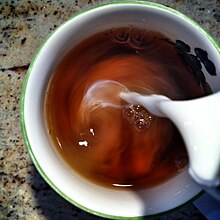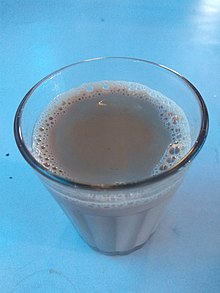| Revision as of 18:48, 18 August 2020 editHorse Eye Jack (talk | contribs)Extended confirmed users10,961 edits →Milk Tea Alliance← Previous edit | Revision as of 22:47, 9 September 2020 edit undoTelsho (talk | contribs)Extended confirmed users1,833 edits A "See also" section will suffice as the entire text was copied verbatim from its main article, copying within Misplaced Pages violationNext edit → | ||
| Line 8: | Line 8: | ||
| ==Variations== | ==Variations== | ||
| Local variations include: | Local variations include: | ||
| *], also known as ''pearl milk tea'' or ''boba milk tea'', a Taiwanese tea-based drink invented in ] in the 1980s | *], also known as ''pearl milk tea'' or ''boba milk tea'', a Taiwanese tea-based drink invented in ] in the 1980s now popular throughout Asia such as Japan, Singapore and South Korea | ||
| *Cambric tea, a sweetened hot-milk beverage, often made with a small amount of tea<ref>{{Cite web|url=https://www.merriam-webster.com/dictionary/cambric+tea|title=Definition of CAMBRIC TEA|website=www.merriam-webster.com}}</ref> | *Cambric tea, a sweetened hot-milk beverage, often made with a small amount of tea<ref>{{Cite web|url=https://www.merriam-webster.com/dictionary/cambric+tea|title=Definition of CAMBRIC TEA|website=www.merriam-webster.com}}</ref> | ||
| *], black tea sweetened with evaporated milk originating from the days of ] in ] | *], black tea sweetened with evaporated milk originating from the days of ] in ] | ||
| *], literally 'milk and tea leaves', a tea beverage drunk in ], ], ], and ] | *], literally 'milk and tea leaves', a tea beverage drunk in ], ], ], and ] | ||
| *], a kind of milk tea popular in ] and ] | *], a kind of milk tea popular in ] and ] | ||
| *], a salty Mongolian milk tea | *], a salty ] milk tea | ||
| *], a Yemeni milk tea served after chewing ] | *], a Yemeni milk tea served after chewing ] | ||
| *], also known as ''masala tea'', is a spiced milk tea drunk in the ] | *], also known as ''masala tea'', is a spiced milk tea drunk in the ] | ||
| *], a type of milk tea made with pure milk mixed with ], prepared in Iranian-style cafes in ], ] | *], a type of milk tea made with pure milk mixed with ], prepared in Iranian-style cafes in ], ] | ||
| *], a sweet tea-based drink popular in Southeast Asia | *], a sweet tea-based drink popular in Southeast Asia | ||
| *Royal milk tea, a Japanese preparation that involves ] tea in milk<ref>{{Cite web|url=http://terms.naver.com/entry.nhn?docId=2180488&cid=43667&categoryId=43667|title=밀크티|language=ko|trans-title=Milk|website=시사상식사전, 박문각|publisher=Naver|access-date=March 22, 2018}}</ref> | *Royal milk tea, a Japanese preparation that involves ] tea in milk, also popular in Singapore<ref>{{Cite web|url=http://terms.naver.com/entry.nhn?docId=2180488&cid=43667&categoryId=43667|title=밀크티|language=ko|trans-title=Milk|website=시사상식사전, 박문각|publisher=Naver|access-date=March 22, 2018}}</ref> | ||
| *] milk tea, milk tea sweetened with traditional Korean dalgona, a honeycomb-like toffee<ref>{{Cite web|title=The real Dalgona coffee, in Korea {{!}} Eat Your World|url=https://eatyourworld.com/destinations/asia/korea/photos/authentic_dalgona_coffee_or_tea|website=eatyourworld.com|access-date=2020-04-30}}</ref> | *] milk tea, milk tea sweetened with traditional Korean dalgona, a honeycomb-like toffee<ref>{{Cite web|title=The real Dalgona coffee, in Korea {{!}} Eat Your World|url=https://eatyourworld.com/destinations/asia/korea/photos/authentic_dalgona_coffee_or_tea|website=eatyourworld.com|access-date=2020-04-30}}</ref> | ||
| In Britain, when hot tea and cold milk are drunk together, the drink is simply known as ''tea'' due to the vast majority of tea being consumed in such a way. The term ''milk tea'' is unused, although one may specify ''tea with milk'' if context requires it. This may cause confusion for people from cultures that traditionally drink tea without milk. | In Britain, when hot tea and cold milk are drunk together, the drink is simply known as ''tea'' due to the vast majority of tea being consumed in such a way. The term ''milk tea'' is unused, although one may specify ''tea with milk'' if context requires it. This may cause confusion for people from cultures that traditionally drink tea without milk. | ||
| == |
==See also== | ||
| *] | |||
| {{Main|Milk Tea Alliance}} | |||
| The Milk Tea Alliance is a term used to describe an online democratic ] movement made up of ] from ], ], and ].<ref>{{cite web |last1=Tanakasempipat |first1=Patpicha |title=Young Thais join 'Milk Tea Alliance' in online backlash that angers Beijing |url=https://mobile.reuters.com/article/amp/idUSKCN21X1ZT?__twitter_impression=true |website=mobile.reuters.com |publisher=Reuters |accessdate=18 April 2020}}</ref><ref>{{cite web |last1=Bunyavejchewin |first1=Poowin |title=Will the ‘Milk Tea War’ Have a Lasting Impact on China-Thailand Relations? |url=https://thediplomat.com/2020/05/will-the-milk-tea-war-have-a-lasting-impact-on-china-thailand-relations/ |website=thediplomat.com |publisher=The Diplomat |accessdate=4 May 2020}}</ref> The Milk Tea Alliance arose in response to the increased presence of Chinese trolls and nationalist commentators on social media.<ref>{{cite web |last1=McDevitt |first1=Dan |title=‘In Milk Tea We Trust’: How a Thai-Chinese Meme War Led to a New (Online) Pan-Asia Alliance |url=https://thediplomat.com/2020/04/in-milk-tea-we-trust-how-a-thai-chinese-meme-war-led-to-a-new-online-pan-asia-alliance/ |website=thediplomat.com |publisher=The Diplomat |accessdate=18 April 2020}}</ref><ref>{{cite web |last1=Lau |first1=Jessie |title=Why the Taiwanese are thinking more about their identity |url=https://www.newstatesman.com/international/places/2020/05/taiwanese-independence-taiwan-china-beijing-identity-hong-kong |website=www.newstatesman.com |publisher=New Statesman |accessdate=15 May 2020}}</ref> Milk tea is seen as a symbol of anti-China solidarity by southeast Asians because in many southeast Asian countries tea is historically consumed with milk while in China it is not.<ref name="The Print" >{{cite web |last1=Deol |first1=Taran |title=‘We conquer, we kill’: Taiwan cartoon showing Lord Rama slay Chinese dragon goes viral |url=https://theprint.in/world/we-conquer-we-kill-taiwan-cartoon-showing-lord-rama-slay-chinese-dragon-goes-viral/443814/ |website=theprint.in |publisher=The Print |accessdate=18 June 2020}}</ref> Australia has also been suggested to be a member of the Milk Tea Alliance, however the relation to milk tea is tenuous with the milk product Aptamil standing in for an actual variety of milk tea in imagery.<ref>{{cite web |last1=Everington |first1=Keoni |title=Photo of the Day: Australia joins Milk Tea Alliance with Taiwan |url=https://www.taiwannews.com.tw/en/news/3925084 |website=www.taiwannews.com.tw |publisher=Taiwan News |accessdate=30 April 2020}}</ref> | |||
| The "Milk Tea Alliance" moniker emerged in 2020 after Chinese nationalist Internet commentators criticised the Thai actor ] for "liking" an image on Twitter which referred to Hong Kong as a "country", and called for a boycott of his TV programme. Twitter users in Taiwan, Hong Kong, and the Philippines joined Thai users in what ''The Telegraph'' called "a rare moment of regional solidarity".<ref name="telegraph2020">{{cite news |last1=Smith |first1=Nicola |title=#MilkTeaAlliance: New Asian youth movement battles Chinese trolls |url=https://www.telegraph.co.uk/news/2020/05/03/milkteaalliance-new-asian-youth-movement-battles-chinese-trolls/ |work=] |date=3 May 2020}}</ref> Following the ] India has also been included in some formulations of the Alliance with masala chai being their representative variety of milk tea.<ref name="The Print" /> | |||
| Pallabi Munsi, writing in ] described the Milk Tea Alliance taking on 50 Cent Party and ] as "Asia's volunteer army rising against China's internet trolls."<ref>{{Cite web|last=Munsi|first=Pallabi|date=2020-07-15|title=The Asian Volunteer Army Rising Against China’s Internet Trolls|url=https://www.ozy.com/around-the-world/the-asian-volunteer-army-rising-against-chinas-internet-trolls/334518/|url-status=live|archive-url=|archive-date=|access-date=2020-07-30|website=OZY}}</ref> | |||
| ==References== | ==References== | ||
Revision as of 22:47, 9 September 2020
For other uses, see Milk tea (disambiguation). Beverage mainly composed of tea and milk

Milk tea refers to several forms of beverage found in many cultures, containing some combination of tea and milk. Beverages vary based on the amount of each of these key ingredients, the method of preparation, and the inclusion of other ingredients (varying from sugar or honey to salt or cardamom). Instant milk tea powder is a mass-produced product.
Variations
Local variations include:
- Bubble tea, also known as pearl milk tea or boba milk tea, a Taiwanese tea-based drink invented in Taichung in the 1980s now popular throughout Asia such as Japan, Singapore and South Korea
- Cambric tea, a sweetened hot-milk beverage, often made with a small amount of tea
- Hong Kong-style milk tea, black tea sweetened with evaporated milk originating from the days of British colonial rule in Hong Kong
- Doodh pati chai, literally 'milk and tea leaves', a tea beverage drunk in India, Pakistan, Nepal, and Bangladesh
- Teh tarik, a kind of milk tea popular in Malaysia and Singapore
- Suutei tsai, a salty Mongolian milk tea
- Shahi haleeb, a Yemeni milk tea served after chewing qat
- Masala chai, also known as masala tea, is a spiced milk tea drunk in the Indian subcontinent
- Irani chai, a type of milk tea made with pure milk mixed with mawa, prepared in Iranian-style cafes in Hyderabad, India
- Thai tea, a sweet tea-based drink popular in Southeast Asia
- Royal milk tea, a Japanese preparation that involves decocting tea in milk, also popular in Singapore
- Dalgona milk tea, milk tea sweetened with traditional Korean dalgona, a honeycomb-like toffee
In Britain, when hot tea and cold milk are drunk together, the drink is simply known as tea due to the vast majority of tea being consumed in such a way. The term milk tea is unused, although one may specify tea with milk if context requires it. This may cause confusion for people from cultures that traditionally drink tea without milk.
See also
References
- "Franchise battle stirring up Vietnamese milk tea market". VietNamNet. September 15, 2017. Retrieved September 22, 2017.
- Zeng, Z.; Wang, J. (2010). Advances in Neural Network Research and Applications. Lecture Notes in Electrical Engineering. Springer Berlin Heidelberg. p. 894. ISBN 978-3-642-12990-2. Retrieved September 22, 2017.
- "Definition of CAMBRIC TEA". www.merriam-webster.com.
- "밀크티" [Milk]. 시사상식사전, 박문각 (in Korean). Naver. Retrieved March 22, 2018.
- "The real Dalgona coffee, in Korea | Eat Your World". eatyourworld.com. Retrieved 2020-04-30.
Further reading
- "Milk-tea-flavored bottled water". Japan Today. Retrieved September 22, 2017.
External links
- [REDACTED] Media related to Milk tea at Wikimedia Commons
| Tea (Camellia sinensis) | |||||||||||||||
|---|---|---|---|---|---|---|---|---|---|---|---|---|---|---|---|
| Common varieties |
| ||||||||||||||
| General | |||||||||||||||
| Culture |
| ||||||||||||||
| History | |||||||||||||||
| Production and distribution |
| ||||||||||||||
| Preparation | |||||||||||||||
| Health | |||||||||||||||
| Tea-based drinks | |||||||||||||||
| See also |
| ||||||||||||||